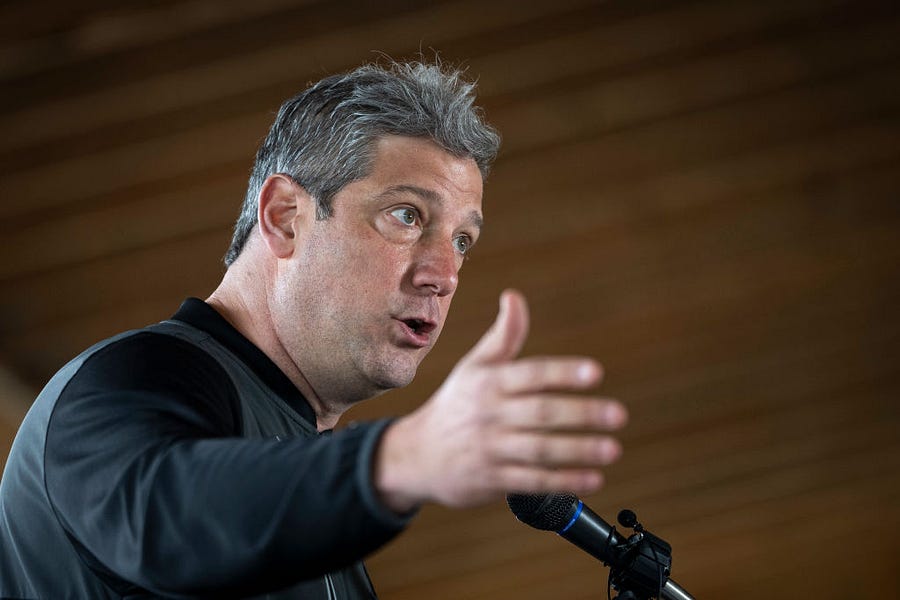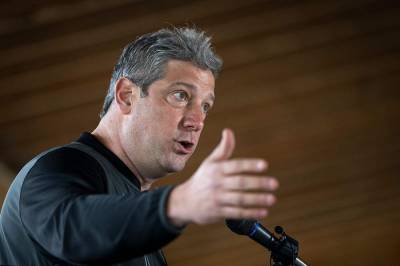Rep. Tim Ryan may be running for an Ohio Senate seat as a Democrat, but he’s letting Fox News personalities do the talking in his campaign ads. It may be his best hope of winning in a Republican-leaning state—especially given his voting record on Capitol Hill.
“Tim Ryan is obviously somebody who’s pitching the more moderate ideas,” says Fox News reporter Peter Doocy in one snippet. “You’re very moderate, I mean, you’re hanging out in the middle like most of us are,” Fox Business host Maria Bartiromo tells Ryan in another. Those clips, alongside others featuring Bret Baier and Tucker Carlson, ran in a July television ad meant to depict Ryan as a commonsense liberal.
“You don’t have to take it from me,” Ryan said in a July tweet about the ad. “Even Fox News will tell you I’ll always put Ohio first.”
Yet Ryan has voted with President Joe Biden 100 percent of the time and largely avoids describing himself as a “moderate” in his bid against the Donald Trump-endorsed Republican J.D. Vance.
Aside from a few areas of agreement with Trump—and his decision to run against Democratic Rep. Nancy Pelosi for speaker in 2016—Ryan is nearly indistinguishable from the average congressional Democrat. This Congress, he voted for the roughly $730 billion Inflation Reduction Act, as well as a House-passed gun control bill that would ban high capacity magazines and raise the purchasing age for semiautomatic weapons from 18 to 21 years old. Following the overturning of Roe v. Wade in June, Ryan also voted in favor of the Women’s Health Protection Act, which would ban restrictions on a woman’s right to an abortion before fetal viability and ban state-mandated waiting periods and ultrasounds.
Unlike centrist Democratic Sens. Joe Manchin of West Virginia and Kyrsten Sinema of Arizona, Ryan told The Dispatch recently that he’s “for getting rid of the filibuster,” the upper chamber’s 60-vote threshold for passing legislation.
“Tim Ryan pretends to be a moderate in his slick TV ads, but behind closed doors, he admits he’s a progressive,” said Luke Schroeder, spokesman for the Vance campaign.
Ryan typically opts for “independent” and “post-partisan populist” to describe his platform during interviews or on the campaign trail and disputes the centrist label. When a Fox News reporter asked him this month about “campaigning as a moderate,” Ryan clarified: “Well, I’m campaigning as an independent really,” before rattling off examples of when he bucked the party line: supporting Trump’s nomination of retired Marine Gen. Jim Mattis for secretary of defense, voting for the U.S.-Mexico-Canada agreement, and backing the creation of a Space Force. “It’s frustrating for them to try to pigeonhole me,” he said of the Vance campaign in an interview last month.
It’s no surprise that on the campaign trail Ryan focuses on international trade. “When Obama’s trade deal threatened jobs here, I voted against it. And I voted with Trump on trade,” Ryan tells voters in one 30-second TV ad. “I don’t answer to any political party. I answer to the folks I grew up with and the families like yours all across Ohio.” In another ad, he says the word China a half-dozen times to emphasize his campaign’s economic populist focus.
Ryan’s focus on American manufacturing isn’t that different from the approach taken by Ohio’s senior U.S. senator, Democrat Sherrod Brown, who votes with Biden 98 percent of the time according to FiveThirtyEight. “He’s talked about a populist economic message that is a lot like I’ve done and that no Republican’s done,” Brown said Monday. “It’s how I win Ohio. It’s how he’s gonna win Ohio.” If elected, expect Ryan to govern more like his home-state colleague than Manchin or Sinema.
Vance, a venture capitalist and bestselling author of Hillbilly Elegy, is also stumping on a populist message focused on restoring American manufacturing jobs, preserving a strict trade relationship with China, and cracking down on illegal immigration.
The race is far closer than expected. Vance leads in the latest polls from Emerson College/The Hill (four points as of September) and Trafalgar Group (nearly three points as of August), while a September Suffolk University Poll showed Ryan slightly ahead. And Ryan is dominating in fundraising: He raised more than $9 million to Vance’s $2.3 million in the second quarter of this year, for example.
Then there’s Biden. Ryan endorsed Biden in the 2020 Democratic primary after his own presidential campaign failed to gain traction. But when the president visited the state in July, Ryan was nowhere to be seen. And a day before he chose to appear with Biden at a September groundbreaking at an Intel plant, Ryan said “my hunch is that we need new leadership across the board,” when asked if Biden should seek re-election. No wonder: Fifty-five percent of Ohio adults said they disapprove of the president, according to a mid-September poll from Marist College.
Even Vance admits that Ryan is effective at toeing this line. “I actually spoke to a donor yesterday who told me that he thought Tim Ryan was running in the Republican primary,” Vance told NBC News this summer. But he insists that Ryan’s economic populism is a facade, telling voters at a Trump rally in Youngstown last weekend that there is “campaign Tim, who pretends he’s a moderate” and “D.C. Tim, who votes 100 percent of the time with Joe Biden.”







Please note that we at The Dispatch hold ourselves, our work, and our commenters to a higher standard than other places on the internet. We welcome comments that foster genuine debate or discussion—including comments critical of us or our work—but responses that include ad hominem attacks on fellow Dispatch members or are intended to stoke fear and anger may be moderated.
With your membership, you only have the ability to comment on The Morning Dispatch articles. Consider upgrading to join the conversation everywhere.